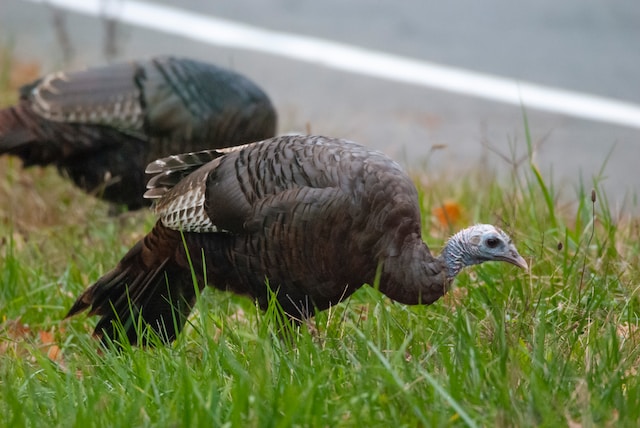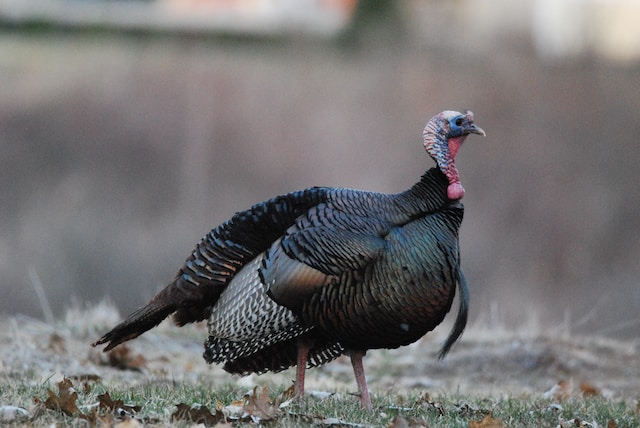Tom Vs Hen Turkey: How To Tell The Difference


Hunting turkeys can be a thrilling experience, but it’s important to know what you’re hunting. Telling the difference between a hen and a tom turkey is crucial for any turkey hunter.
Not only is it important for hunting regulations, but it can also affect the quality of the meat you bring home.
One of the most obvious differences between a hen and a tom turkey is their size. Toms are typically larger than hens, with longer legs and a larger body.
However, size alone isn’t always a reliable indicator of gender. It’s important to look for other physical characteristics as well, such as the shape of their heads and the color of their feathers.
Another key difference between hens and toms is their behavior. During the spring mating season, toms will often strut and gobble to attract hens.
Hens, on the other hand, tend to be quieter and more reserved. By observing their behavior, you can often determine their gender before even getting a close look.
With these tips in mind, any turkey hunter can confidently identify the gender of their prey and have a successful hunt.
Understanding the Basics of Turkey Anatomy
Head and Neck
The head and neck of a turkey are key features to look for when trying to differentiate between a hen and a tom turkey. Male wild turkeys, also known as toms, have a larger head and a longer neck than female turkeys, or hens.
Toms have a fleshy protuberance on their head called a snood, which can change size depending on the turkey’s mood. Additionally, toms have a wattle, which is a flap of skin that hangs down from their neck. Both the snood and wattle are more prominent and larger in toms than in hens.
Body
When it comes to the body, there are a few key differences to look for. Toms are generally larger than hens, with longer legs and thicker thighs.
They also have spurs, which are bony growths on the back of their legs. These spurs are more developed and longer in toms than in hens.
Another distinguishing feature is the presence of a beard. Toms have a beard, which is a tuft of hair-like feathers that grows from their chest. Hens do not have a beard.
Finally, plumage is an important factor to consider. Toms have more colorful feathers than hens, with iridescent feathers on their tail and breast. Hens have more muted coloration overall.
In summary, understanding the basics of turkey anatomy can help hunters distinguish between toms and hens. By paying attention to the size, spurs, beard, head and neck features, and plumage, hunters can increase their chances of a successful hunt.
Identifying Toms and Hens
Physical Characteristics
Male turkeys, also known as toms, are generally larger than female turkeys, or hens. Toms can weigh up to 30 pounds, while hens typically weigh between 8 and 12 pounds.
Toms also have larger, more colorful heads with a fleshy wattle, or snood, that hangs down over their beak. Their feathers are typically darker and more iridescent than those of hens, and they have a longer, more pronounced beard of feathers on their chest.
Hens, on the other hand, have smaller heads with a blue-gray coloration, and their feathers are more muted in color. They also lack the prominent snood and beard of the tom turkey.
Behavioral Characteristics
Male turkeys are known for their distinctive gobbling calls, which they use to attract females during mating season. They also make a variety of other vocalizations, including clucks and yelps, and will often puff up their feathers and fan out their tail feathers in a display of dominance.
Hens, on the other hand, are generally quieter and less showy than toms. They may make soft clucking or purring sounds to communicate with their young or other members of their flock, but they do not typically gobble or fan their tail feathers.
When hunting turkeys, it is important to be able to distinguish between toms and hens. By paying attention to both the physical and behavioral characteristics of these birds, hunters can ensure that they are targeting the appropriate gender and avoid accidentally shooting a hen.
Differentiating Between Jakes and Mature Toms
For novice turkey hunters, it can be challenging to differentiate between a jake and a mature tom. However, with a little bit of knowledge and experience, hunters can learn to tell the difference between the two.
One of the most noticeable differences between jakes and mature toms is their size. Mature toms are significantly larger than jakes, weighing around 20-30 pounds, while jakes weigh around 10-15 pounds. However, size alone is not enough to determine the age of a turkey.
Another way to differentiate between jakes and mature toms is by examining their tail feathers. Mature toms have longer and more prominent tail feathers than jakes. In contrast, jakes have shorter and less distinct tail feathers.
When it comes to coloration, jakes tend to have brighter and more vibrant feathers than mature toms. Mature toms have more muted and darker feathers, with less iridescence. Additionally, mature toms have beards and spurs that are longer and more prominent than those of jakes.
During the summer months, jakes can be more challenging to differentiate from mature toms, as their feathers and size can be similar. However, hunters can still use the above characteristics to help determine the age of the turkey they are hunting.
In summary, hunters can differentiate between jakes and mature toms by examining their size, tail feathers, coloration, beards, and spurs. With a little bit of knowledge and experience, hunters can become more confident in their ability to tell the difference between the two.
Conclusion
Identifying the gender of a turkey is crucial for turkey hunting. A hunter must be able to distinguish between a hen and a tom turkey to avoid making mistakes that could lead to legal issues or ethical concerns.
The differences between the two genders are subtle, but with practice and knowledge of the key characteristics, hunters can confidently identify the gender of a turkey.
When hunting, it is important to observe the behavior of the turkey. Hens are typically quieter and more reserved, while toms are more vocal and aggressive.
Additionally, the appearance of the head and feathers can also be helpful in identifying the gender. Toms have a larger head with a more pronounced snood and caruncle, while hens have a smaller head with a less noticeable snood and caruncle.
Another key characteristic to look for when identifying the gender of a turkey is the presence of a beard. Only toms have beards, which are long, thin, and black feathers that protrude from the chest. However, not all toms have beards, and some hens may have small beards as well.
When in doubt, it is best to refrain from shooting until the gender can be positively identified. Taking the time to observe and identify the turkey can also provide valuable information about the breeding habits and population of the species in the area.
It is important to be responsible and ethical when hunting to ensure the sustainability of the turkey population for future generations.
